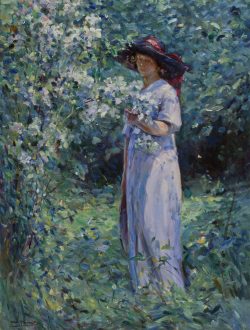George F. Schultz 1869–1934
Relatively little is known of George F. Schultz’s biography, notwithstanding the artist’s active presence in local exhibitions in Chicago between the 1890s and the 1910s. Schultz was a Chicago native who began his career as a decorative painter on china. He trained briefly at the Art Institute of Chicago, in 1892, but was said to be self-taught. Specializing in watercolor painting, Schultz began exhibiting in the Art Institute’s annual exhibition for watercolors and pastels in 1889. His work was also shown at O’Brien’s Gallery in 1892 and in the shop he operated jointly with fellow artist William Wilson Cowell in 1893 on Chicago’s Rush Street. Thurber’s Gallery gave Schultz a well-received solo exhibition in 1896 followed by another in 1898, and his work appeared repeatedly in the Art Institute’s various annuals until 1925. Schultz’s watercolors were the subject of a small solo exhibition at the Art Institute in 1907. That year, he became a charter member and secretary of the Chicago Water Color Club; in 1912 he was elected its president. Schultz was awarded the Tuthill Prize in the Art Institute’s annual exhibition of watercolor paintings in 1918. The following year, the Marshall Field and Company department store presented the artist’s last-known solo exhibition.
Landscapes and marines predominated in Schultz’s work throughout his career. His generalizing titles give little hint of locale, but he worked in Delavan, Wisconsin, in the 1890s and later painted in Mexico and Indiana as well as Illinois, even painting the urban Chicago River. The coast of Maine, notably Monhegan Island, was Schultz’s favorite setting. He painted there for much of 1895 and was still creating Monhegan landscapes as late as 1918. Schultz’s watercolor renderings of sunlight and shadow on rocky shores attracted particular praise. Around 1910 he began painting woodland scenes, and three years later he added female figures in several such works made in oils. These paintings indicate a turn toward the bright color, rapid brushwork, dappled sunlight, and garden settings beloved of American adherents of impression. Yet for the last exhibited works of his career, in the early 1920s, Schultz returned to the theme of coastal landscape on which his reputation rested.
Wendy Greenhouse, PhD
